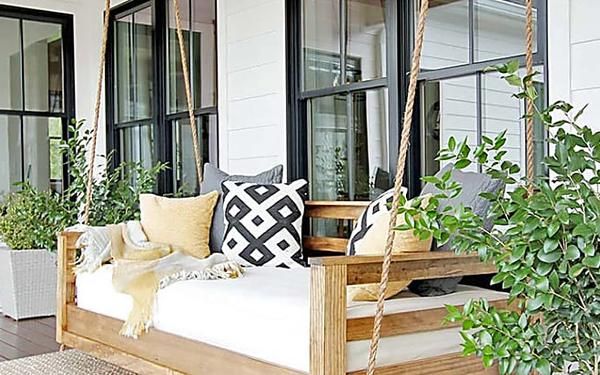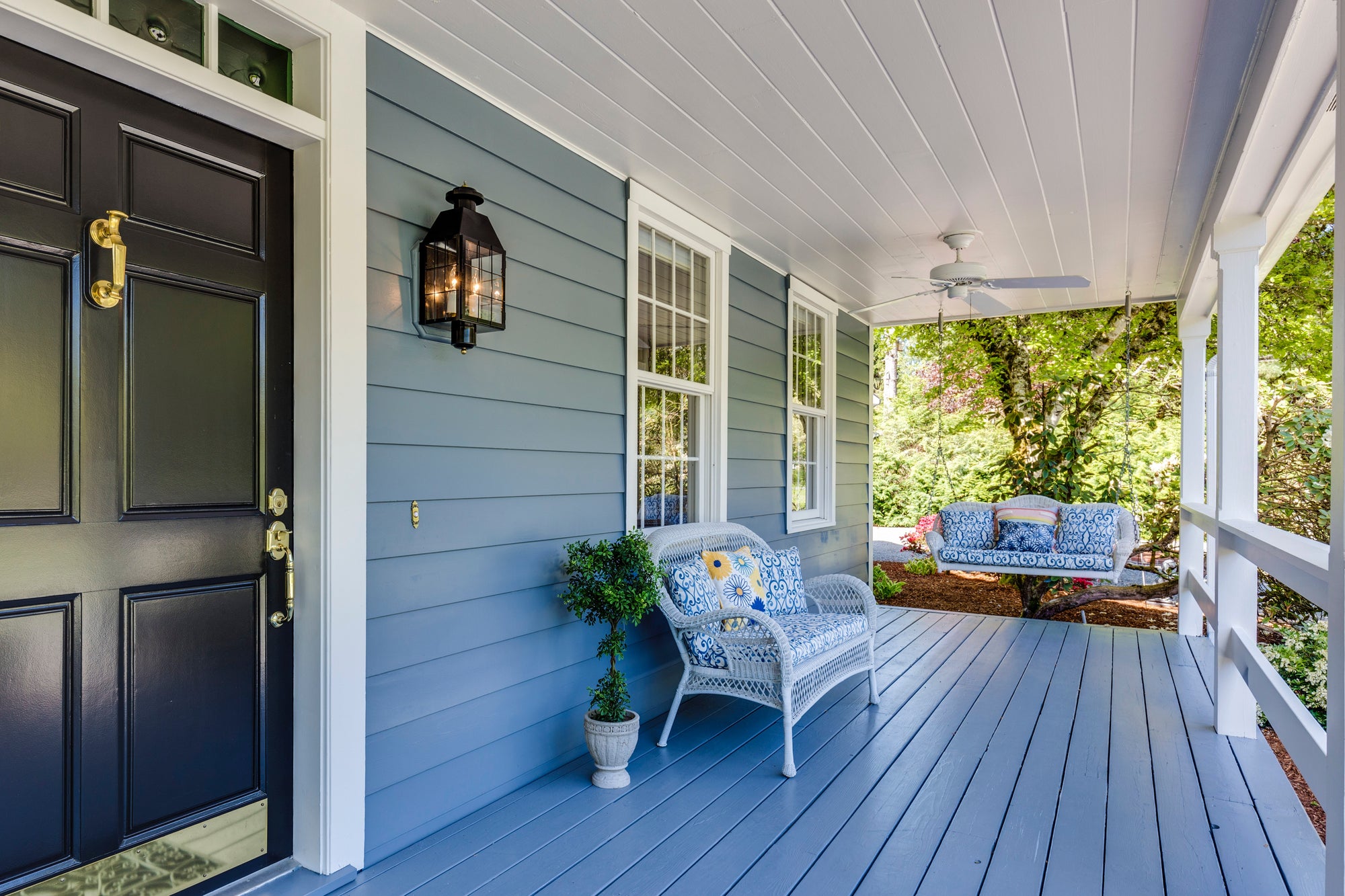
There is something romantic about a porch swing. They welcome long conversations with loved ones on relaxed afternoons or become a cozy respite to curl up on with a good book and sweet tea.
Porch swings invite a whimsical Americana charm that instantly adds curb appeal to any home. It’s a design element that will simply never go out of style. It is a timeless piece where memories are made.
The History of The Porch Swing
 You’ve surely heard of, and likely sat on, a porch swing. The conventional porch swing is bench-like seating crafted with painted or stained wood.
You’ve surely heard of, and likely sat on, a porch swing. The conventional porch swing is bench-like seating crafted with painted or stained wood.
Usually intended for adults, the swing’s suspension chains are permanently mounted to the porch ceiling and provide a relaxing rocking sensation. Porch swings are typically large enough to seat two to three people and are often considered an alternative to rocking chairs or gliders. While traditional porch swings are suspended, there are alternative glider/swing combinations that sit on the ground, such as the 1950s model picture above.
You might be surprised to learn that porch swings date back to 1450 BC — though British engineer Charles Wicksteed is credited with designing the version we commonly see today in the early 1900s, according to home and gardening website, Fifthroom Living. The swings used to be a staple at playgrounds but started showing up on household front porches in the 19th century.
Today, people have been known to hang them from their back porch, a swing stand in their garden, and even indoors.
Factors to Consider Before Buying a Porch Swing
Figuring out where and how you’ll use your porch swing is the first step in selecting the right style for your home. Determining the strength of your roof or ceilings joists and factoring the regional climate in your area should be considered before making your selection.
There are several types materials used to craft outdoor porch swings, most commonly are plastic, metal, wood or wicker. Plastic and metal options tend to withstand rain and snow while wicker is known for being lightweight and fairly easy to clean. Real wood porch swings are still the most popular and durability options, so if you have your heart set on wood you can coat the swing with waterproof sealants to make them weather-resistant.
Hanging swings aren’t just for the outdoors, you can hang them indoors as well. Wherever you choose to mount you hanging swing the most important step is to locate solid ceiling joists.
“If you don’t find a solid joist, installers risk attaching the swing mount to a ceiling that cannot support it, or worse—it will pull the ceiling down on the person sitting in the swing,” Alan Chenkin, a D.C.-based carpentry expert, told Beautiful Home. “If the only spot you have for a swing can't support the load, you have to consider an alternate location or using a mounting plate.”
Chenkin suggests choosing a spot that allows for at least three feet of space behind the swing, and at least 14 inches on either side to prevent hitting a wall or railing.
If you’re looking for the best of all worlds the solid wood, indoor/outdoor Organic Swing model is your best choice.
The Organic Swing Difference 
Like many tried and true inventions, there have been modern developments in the past several years that have transformed the traditional notion of a porch swing.
Enter Organic Swing. The United States-based company is putting a modern spin on the old classic. The minimalist design swaps traditional wood-slat swings in favor of a look that’s befitting of today’s modern-day homes.
Organic Swing’s slender steel frame and inlaid cypress boards combine contemporary style and modern versatility that lasts a lifetime. But it’s the interchangeable backrest design that makes Organic Swing really stand out.
The two removable backrests can be easily reconfigured into multiple different positions by dropping the pieces into an array of square holes around the perimeter of the seat. It can transform from a traditional porch swing to a luxurious lounger or an intimate face-to-face conversation space You can face the seats forward or backward depending on the view you want. A back-to-back orientation can facilitate more focused personal time for two individuals.
These American-made swings are precision-cut from hardwearing cypress hardwood. The high-quality materials offer unrivaled resistance to damage from the elements and insects, and provide the natural wood-grain patterns found in only the highest-grade lumber.
The cypress wood pieces are set on a lightweight, steel frame and suspended from galvanized, aircraft-grade steel cable for a distinctively modern look and added strength. Frames are powder-coated to provide maximum durability against scratching and wear. These frames are resistant to rust.
Since its founding nearly a decade ago, Organic Swing has been featured in the Wall Street Journal, Design Milk, and other high-end publications for its innovative design.
“The appeal of kicking back in a gently swaying porch swing is pretty universal, but traditional wood-slat swings often don’t match the aesthetic of a modern home,” Rob Wotzak, product writer for Fine Homebuilding Magazine, wrote in a 2016 article. “That dilemma is what inspired Mississippi craftsman Andy Hilton to design Organic Swing, a minimalist nod to the classic porch swings he grew up with. Organic Swing’s slender frame and inset cypress boards create a clean and simple form that will look good anywhere.”
Porch swings have come a long way from their invention, but ultimately still provide the perfect place for entertaining or slipping away for a quiet moment alone. And with Organic Swing, the modern porch swing has never been more stylish and versatile.



